The past week started off with more of a whimper than a bang.
On Friday, Saturday and Sunday, we went through a three-day string of no appreciable interactions with humpback whales. That's unusual for this time of year. And, well…it kinda sucked.
Naturally, we were a bit worried, particularly given the generally slow start to the season over the previous few weeks, but fortunately, our luck changed on 16 August, when the weather settled, skies cleared, and the whales showed up again. Whew!
Over the past few days, we've been fortunate enough to see a variety of humpback whale behaviour.
We photo-identified three more baby whales (Saipe, Ikumi, Lahi), bringing the total to six, and we had repeat encounters with two of those three.
We swam with an intense six-whale heat run, found a couple of singers, watched a number of mother/ calf pairs that were moving too much to see in the water, saw male humpbacks battle one another for the right to become escort whales, and got totally confused by a pair of perplexing whales.
First Contact
First contact with cetacean life this week came in the guise of a heat run.
If you've read any of my posts about humpbacks over the years, you'll know that I love heat runs. A lot.
If you don't know what a heat run is, in short, it's a bunch of testosterone-crazed male humpbacks chasing after a female whale while snorting, grunting, and cajoling one another, sometimes resorting to body slams, head butts, tail slaps and other acrobatics worthy of the most theatrical of pro wrestling matches.

Three male humpback whales in a six-whale heat run
In this case, the heat run involved six whales, and the intensity was about a six on a scale of one to ten…not too violent to get in, not too relaxed to be dull.
For the six people who were on the boat with me, it wasn't the easiest of introductions to humpback whales (since observing heat runs often requires swimming as hard as you can for as long as you can), but it was worth the effort.
At one stage, the whales completely surrounded our boat, meaning that they were comfortable with our presence and had sort of "taken us in" to their movements.
After we made several unsuccessful attempts to see them in the water, the whales rewarded us with a high-speed, mid-water fly-by when the hormone-driven cetaceans decided to turn around and take a look at us.
J, one of the guys in the water at the time, came up whooping with joy, remarking that it was sight he would never forget, later describing the experience as like being "in a washing machine with six locomotives" charging through.
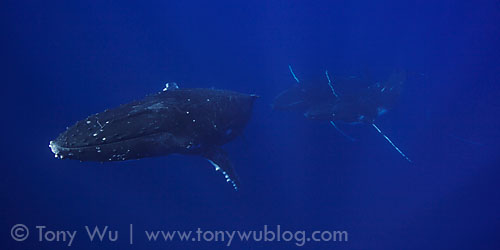
J said: "It's like being in a washing machine with six locomotives!"
Baby Humpback Whales
Almost immediately after that, we found a mother, calf and escort in nice, clear water.
This baby turned out to be the 4th one we've photo ID-ed this season. I named it Saipe, which means "OK" or "alright" in Tongan, because I felt much better after finding the heat run and this baby following the three-day dry spell.
Unfortunately, however, we only had one good swim with this baby. It was a textbook-perfect swim, with the whales completely relaxed while we were in the water, but they suddenly dashed off into the blue and wouldn't stop.
We saw another whale pop up nearby, and speculated that this may have had something to do with the whales' sudden change in mood. The escort surfaced a couple of times by itself, floated in the water and growled in the general direction of the other whale. I didn't get the impression that it was a neighborly greeting.
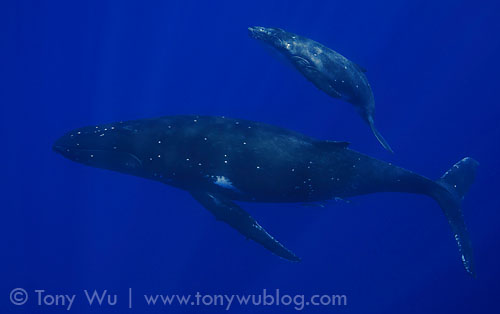
Saipe (4th ID-ed calf this season) with mother
Speaking of which, the mood of the season seems to be summed up in a single word…unsettled. Just about every whale we've encountered to date has been active, meaning they're swimming all over the place, often heading straight out to sea or straight past the islands.
In a given hypothetical "average" year, there would be many more encounters with whales that don't seem to be in a rush to get some place.
Although this itchy-fin syndrome extends to mother/ calf pairs, our pace of ID-ing mother/ calf pairs so far is on track with this point in 2008 and 2009. So even though it's been relatively difficult to find mother/ calf pairs relaxed enough for easy encounters, there seems to be a number of babies around.
Besides, Saipe, we ID-ed two more calfs this week (Ikumi and Lahi), bringing the total count to six. We also encountered three additional calfs that we were only able to observe from above the water line, bringing the total unknown calf count to seven.
No one is sure why the whales seem so restless. For now, I'm still thinking along the lines of what I outlined last week, namely that there are may be relatively few breeding-ready females this season, meaning greater competition for the females that are present.
Many of the mothers and calfs we've seen have had escorts, and in two instances, we've seen other males confront the escorts in an attempt to dislodge him.
On our last day on the water this week, for example, we found a mother/ calf/ escort group heading slowly out to sea. First one, then another male intercepted them and challenged the escort.
After a bit of aquatic mayhem, the original escort emerged victorious and chased off the interlopers, but…here's the interesting part…the two losers joined forces and formed a temporary alliance, trailing behind the mother/ calf/ escort at a safe distance, perhaps hoping to make another attempt.
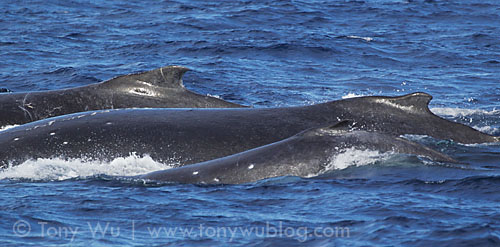
Unidentified baby whale with mother and escort
This type of behaviour itself isn't so unusual, but to see so many escorts accompanying mothers with babies at this stage in the season, as well as males challenging existing escorts…does seem somewhat out of the norm.
In short, I'm still going with the theory that an abundance of horny males + paucity of available females = restless population.
(Note: If you're visiting Vava'u and would like to help with calf IDs, please see this PDF file with an explanation of the information I'm seeking.)
Quantum Entanglement
After the two whales that challenged the escort in my anecdote above lost, we followed for a while, watching the pair of frustrated males track the mother/ calf/ escort group.
At one point, we decided to leave the group, as they were heading too far out to sea.
I joked that as soon as we turned away, the whales were sure to breach. (They had breached several times through the morning when no one with a camera was looking the right way.)
Cary, one of the guys on the trip, casually placed his camera and long lens over his shoulder so that it pointed behind him, quipping that it'd be no problem for him to nail an over-the-shoulder shot of a breach without so much as looking at the whale.
At that precise millisecond, one of the whales breached directly in front of him, at the perfect shooting distance, with really good light. I kid you not.
(Insert video of me laughing uncontrollably.)
It's as if the whale breached just to mock him.
(He deserved it.)
The incident reminded me of the concept of quantum entanglement, in which two physically distinct particles are connected to one another in an as-yet unexplainable manner such that something affecting one particle automatically affects the other, even across vast distances.
Clearly, the whale was entangled with Cary's camera, in a "you'll never get a photo of me breaching" sort of way.
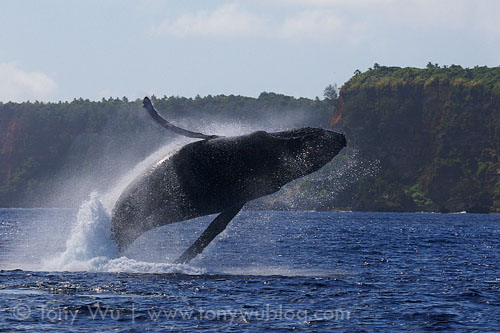
The type of photo Cary didn't get
Cetacean Crooners
We also found two singers, both mature adults.
I found one in almost the exact spot outside Hunga that we found the two immature singers a few weeks back when my friend Dr John Potter was here (see Part 1).
I'm starting to think there's something to that spot, as I've now visually confirmed three singers in that location this season. Every time I cruise by there from now on, I'll be keeping an eye out for additional singers.
I managed to get everyone in directly on top of the whales to see and hear the singers on both days. Both were large males, so the voices boomed and resonated sufficiently that we could hear them even on the boat. It's quite an experience to be above a mature singer in the water, to say the least.
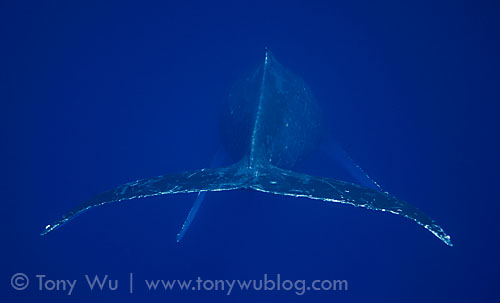
Big, mature humpback whale singer, in the classic head-down pose
On Friday afternoon, we again heard the haunting echoes of whale song through the hull. The crew and I scrambled to get people into the water, only to see J in the cabin…making whale sounds. Hah, hah.
To his credit, J fooled at least five experienced whale watchers. And here I was thinking J had no talent.
Dancing Queen
Perhaps the most rewarding, and the most puzzling, encounter took place on 19 August, just after our encounter with a big singer.
We found the pair just south of the main channel, doing the typical up-and-down resting behaviour…taking a few breaths every 15 minutes or so, then gliding down to the bottom to rest.
Visibility was somewhat milky, so it wasn't easy to keep track of them, but we managed to follow the duo for most of the afternoon.
With such a long encounter, I had a lot of time to observe the whales. Among the things I noted:
- The bellies of the two whales were very similar in pattern.
- One whale required two to three breath cycles for each breath cycle of the other one.
- The one that had to breath more often was curious enough to swing by and take a look at swimmers. The other whale couldn't be bothered.
- The same whale kept nuzzling the other one when they were on the bottom, swimming around it in circles, resting under the other whale's pectoral fin, peeking out from under the other whale, even hiding entirely under the other whale at one point.
Anyone who's spent a significant amount of time in the water with humpbacks will probably reach the same conclusion I did: "It's a calf!"
What sealed it for me was a chance encounter. Since the visibility wasn't great, we lost track of the pair every once in a while. When that happened, I dived down a few metres to look for the whales, then surfaced directly above them so everyone else knew where they were.
On one of the recon missions, the curious whale happened to be coming up at the same time. I didn't see the whale, and it didn't see me, until we met at about the half-way mark, at ten metres or so.
So there we were, suspended in the water, looking at one another. I looked at the whale. It looked at me.
Time froze as we each considered the situation…then the whale went "whoopee!!!" and started to play…twisting, twirling…literally dancing in the water. When I swam around it taking photos, the whale seemed even happier, and soon followed me to the surface, checking out the other swimmers (who probably also said "whoopee!!!").

A friendly juvenile humpback whale dancing in the water
After a few breaths, the whale went down, nudged the other whale a few times, then couldn't resist and came back up to play with us. This happened over and over, with the other disinterested whale surfacing occasionally for air. The playful whale joined the other one each time it came up, but always kept an eye on us, and always came back to play.
It was almost a cut-and-dry "calf from last year" case.
Now here's the thing. I thought I saw mammary slits on the other whale when it dived, which would've made sense had it been a mother.
But, when we checked our photos later that night, we realised that the other whale (the non-playful one) was a male…so definitely not a mom.
Two males: one detached and uninterested; one extremely playful, curious, eager to show off, and prone to nuzzling the other and treating it like its mother.
I have no clue how to characterise this unusual relationship between the two whales.
Anyone have any thoughts?
People
Once again, I was blessed with a terrific gang of fellow adventurers…all a pleasure to spend time with. This trip comprised:
J and Cary, who jointly and severally are the very definition of the term "peanut gallery". Both are quick-witted, and have a great sense of humour and positive attitude. J is making a quick stop in Ha'apai, then heading back home. If you know J, ask him why ostriches eat babies, and call him JJ just to annoy him. Cary is on a yacht heading to Fiji, and looking to find his way to Indonesia, Thailand and other places in Southeast Asia from there.

Standing: Me, Cary, CC, Jenny, Geri. Squatting: J, Colin
Colin, who was foolish enough to join me here after already having been exposed to my nonsense in Lembeh and Bangkok earlier this year. Colin was giving all guys a bad name by making daily Skype calls back to his girlfriend. J and I managed to Skype-jack his final call and proactively "introduce" ourselves to Colin's girlfriend, who no doubt will never let him travel with me again.
Jenny and CC from Taiwan, who had a bit of trouble getting here due to visa issues, but fortunately didn't let it prevent them from making it to Tonga. Jenny is the primary moderator and driving force behind the FiNS communal photo sharing site on Flickr. We've communicated a lot online, but this is the first time we've met in real life. Seeing her big smile as she said: "My dream has come true!" was absolutely priceless. Plus, CC and Jenny have offered to take me out for awesome food next time I'm in Taipei. Time to book a ticket!
And last, but certainly not least, is Geri Murphy. It was a particular honour to have Geri along for the trip. For those of you who remember the glory days of Skin Diver magazine, Geri was one of the primary photographer/ writers.
I read lots(!) of her stories and looked at many of her photos, so being able to share an adventure and spend quality time with one of my heroes is a feeling that is again…priceless.
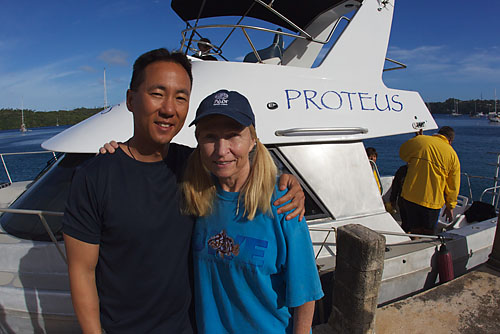
Geri and me
Geri also happens to be great friends with Carl Roessler, who has always provided me with wise counsel at crucial junctures. And Geri's husband, Paul Tzimoulis, was one of the diving industry's all-time greats.
Hearing stories about Paul directly from Geri is something I'll never forget. Though she might not realise this, introducing Geri to humpback whales meant as much or more to me as it did to her.
More people just arrived today for a 10-day trip, so we'll see what the next week-and-a-half holds in store.
Humpback Whales 2011
I'm about half-way through this season, and it's time to commence planning for next year.
If you're interested in joining me in 2011, please sign up for my trip newsletter and/ or drop me a message via my contact form.
Related Posts
Humpback Whales in Tonga 2010 | Part 1
Humpback Whales in Tonga 2010 | Part 2
Humpback Whales in Tonga 2010 | Part 3
Humpback Whales in Tonga 2010 | Part 5
Humpback Whales in Tonga 2010 | Part 6
Humpback Whales in Tonga 2010 | Part 7
Humpback Whales in Tonga 2010 | Part 8